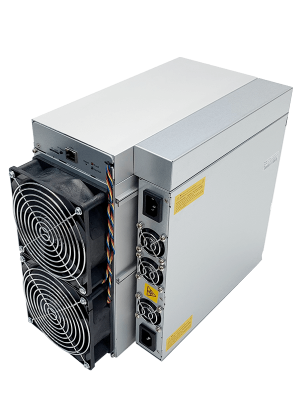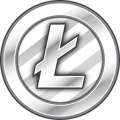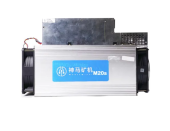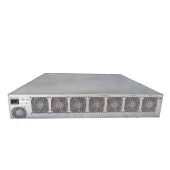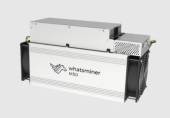Description
ANTMINER L7
This machine, Antminer L7, is among the TOP 5 most profitable machines.
For now, it is the most powerful combined mining ASIC on the market, we are talking about simultaneously mining LITECOIN + DOGECOIN.
Designed to lead the cryptocurrency mining industry, this technology monster is here to take your mining operations to the next level.
Main characteristics:
- Hash performanceThe Antminer L7 has a hash speed of 9.5 gigahashes per second (GH/s) on the proof-of-work Scrypt algorithm. This means it can perform approximately 9.5 gigahashes per second to solve the complex cryptographic problems needed to mine Scrypt-based cryptocurrencies such as Litecoin.
- Power consumptionThe power consumption of the Antminer L7 is around 3425 watts. Energy efficiency is an important factor to consider in cryptocurrency mining, as it affects both the profitability and environmental impact of the mining operation.
- Chip technologyThe Antminer L7 uses ASIC (application specific integrated circuit) chips specially designed for the Scrypt algorithm. These chips are optimized to offer efficient performance and high hashrate in Scrypt-based cryptocurrency mining.
- CoolingThe Antminer L7 is designed with an adequate cooling system to maintain an optimal operating temperature. This is essential to ensure stable performance and prolong the life of the device. The cooling system may include efficient fans and heat sinks.
Scrypt mining:
Scrypt mining is a process by which computer hardware is used to solve complex mathematical problems and validate transactions on the cryptocurrency network using the Scrypt algorithm.
- Scrypt algorithmScrypt is a proof-of-work algorithm used by some cryptocurrencies, such as Litecoin and Dogecoin, among others. Unlike the SHA-256 algorithm used by Bitcoin, Scrypt is designed to be resistant to mining with specialized hardware (ASIC) and encourage mining with CPU and GPU. This makes Scrypt mining more accessible to common users and limits the dominance of large, specialized mining operations.
- Resources requiredScrypt mining requires mainly processing power (hashrate) and memory, which makes it suitable for CPU and GPU mining. Unlike Bitcoin mining, which requires specialized ASIC hardware, Scrypt mining can be performed on personal computers with powerful graphics cards.
- Performance and energy efficiencyScrypt mining performance is measured in kilohashes per second (KH/s), megahashes per second (MH/s) or gigahashes per second (GH/s). Energy efficiency, measured in the amount of energy consumed per unit hashrate, is also an important factor to consider in Scrypt mining.
- Mining poolsScrypt mining can be competitive and individual results can be unpredictable, so many miners choose to join mining pools. Mining pools are groups of miners who combine their processing power to increase the chances of solving blocks and receiving more consistent rewards. Rewards are distributed among miners based on their contribution to the pool's hashrate.
- Rewards and reward block: Scrypt miners receive cryptocurrency rewards for their participation in transaction validation and network security. In the case of Litecoin, for example, the current block reward is 12.5 LTC per block, and is halved approximately every four years in an event known as halving.
It is important to note that cryptocurrency mining, including Scrypt mining, can require significant upfront investment in hardware and power consumption. In addition, the profitability of mining can be affected by factors such as cryptocurrency price, network difficulty and operating costs. If you are interested in Scrypt mining, it is advisable to conduct thorough research and carefully evaluate the costs and benefits before embarking on this activity.
Learn more about LiteCoin:
Litecoin (LTC) is a decentralized, open-source cryptocurrency that was launched in October 2011 by Charlie Lee, a former Google engineer. Although Litecoin is based on blockchain technology, it has some distinctive features compared to Bitcoin and other cryptocurrencies. Here is some basic but important information about Litecoin:
- TargetLitecoin was created with the goal of being an improved version of Bitcoin. It seeks to offer faster transactions, lower transaction costs and more efficient mining.
- AlgorithmUnlike Bitcoin, which uses the SHA-256 proof-of-work algorithm, Litecoin uses the Scrypt algorithm. This algorithm is designed to be more resistant to mining with specialized hardware (ASIC) and allow more accessible mining for common users with CPU and GPU equipment.
- Block and airtimeLitecoin has a target block time of 2.5 minutes, compared to 10 minutes for Bitcoin. This means that Litecoin transactions are confirmed more quickly. In addition, Litecoin has a maximum supply limit of 84 million coins, four times more than Bitcoin's limit.
- Adoption and liquidityLitecoin has gained wide adoption and has a significant user base. It is available on numerous exchanges and is accepted by many merchants as a form of payment. This has contributed to its liquidity and ease of buying and selling.
- SecurityLitecoin benefits from the security provided by blockchain technology and uses advanced cryptography to ensure the integrity of transactions. In addition, Litecoin was one of the first cryptocurrencies to adopt Segregated Witness (SegWit), an upgrade that improved network efficiency and enabled additional features, such as the Lightning Network, for faster and more scalable payments.
- Bitcoin add-onLitecoin is often seen as a complement to Bitcoin. Many users use Litecoin for fast, low-cost transactions between exchanges or to efficiently send value. In addition, Litecoin has served as a testnet to implement features before they are adopted in Bitcoin.
DogeCoin:
DogeCoin (DOGE) is a digital cryptocurrency that originated as a joke in 2013, inspired by the popular meme of the Shiba Inu dog "Doge". Although it started as a parody of other cryptocurrencies, Dogecoin has gained popularity and built an active online community. Below, I provide you with basic but important information about Dogecoin:
- Launch and foundersDogecoin was created by Billy Markus and Jackson Palmer as a fun and friendly version of cryptocurrencies. It was launched in December 2013 and is based on the code base of Luckycoin, which in turn is a fork of Litecoin.
- Supply and issuance: Unlike Bitcoin, which has a maximum supply limited to 21 million coins, Dogecoin has an unlimited supply. In its early years, Dogecoin had a high issuance rate, but in 2014 an upgrade was made to reduce issuance and set a steady rate of 10,000 coins per minute.
- Use and adoptionDogecoin has gained popularity online due to its community and friendly nature. It has been used for social media tips and as a way to support charitable causes and events. Dogecoin has also been accepted by some merchants as a form of payment, although its adoption compared to other larger cryptocurrencies is relatively limited.
- Algorithm and miningDogecoin uses the proof-of-work Scrypt algorithm, just like Litecoin. This allows the cryptocurrency to be mined using common CPU and GPU hardware. However, due to its popularity and community, Dogecoin mining has become more competitive over the years.
- Volatility and speculationDogecoin: Like other cryptocurrencies, Dogecoin has experienced high levels of price volatility. Although not initially thought of as a serious investment, it has attracted the attention of investors and has experienced significant increases in value at certain periods. However, it is important to remember that investing in cryptocurrencies carries risks and market volatility can be high.
